Thursday, May 7th 2020

Assortment of Five AMD B550 Premium Motherboards Pictured
Here are the first pictures of an assortment of five premium AMD B550 chipset motherboards by five different manufacturers. With PCI-Express gen 4.0 (where it matters), CPU+memory overclocking, and multi-GPU being enabled for the B550, and more importantly, the chipset not needing any fan-heatsink, the B550 could be an important chipset for AMD in the battle to come against the 10th generation Core processor and Intel B460 chipset.
We begin with the MSI MPG B550 Gaming Pro Carbon WiFi, the company's most premium B550 offering, picking up the mantle from the immensely successful B450-based predecessor. The MSI board offers a single PCI-Express 4.0 x16 slot, that's reinforced, one M.2 PCIe gen 4.0 x4 slot, a second M.2 slot that's gen 3.0 x4; and a number of x1 slots. The board uses a 14-phase CPU VRM to support CPU overclocking. Connectivity includes 802.11ax WLAN, 1 GbE wired networking, a premium ALC1220-based AudioBoost solution, and heatsinks over both M.2 slots. As a Carbon, it features plenty of RGB LED embellishments.Next up is the ASUS ROG Strix B550-E Gaming, the company's most premium offering based on this chipset, built on its latest design language for the ROG Strix family that's consistent with its Intel Z490 ROG Strix boards. You get a beefy 16-phase CPU VRM, two PCI-Express 4.0 x16 slots (x8/x8 with both populared and with multi-GPU support); two M.2-2280 PCIe x4 slots, from which one is gen 4.0, premium SupremeFX audio solution, 802.11ax WLAN, and 2.5 GbE. There are quite a few overclocker-relevant features such as POST code and diagnostic LEDs.
The GIGABYTE B550 AORUS Master is the company's most premium offering based on this chipset, and is the only other board than the ASRock Taichi to feature three M.2 slots. Like the ASUS Strix-E, you get two PCI-Express 4.0 x16 slots (x8/x8 with both populated); reinforced PCIe and memory slots; a digital POST code, GIGABYTE's premium AMP-UP onboard audio solution, VRM heatinks with real fin-stacks; and 802.11ax + 2.5 GbE connectivity.
The ASRock B550 Taichi is arguably the most premium B550 of this lot. It appears to have the strongest CPU VRM solution, pulling power from two 8-pin EPS connectors, a 16-phase VRM, full front and back metal shrouds, completely reinforced PCIe and memory slots, PCI-Express 4.0 x16 (x8/x8) multi-GPU capability, and a trio of M.2 slots. 802.11ax + 2.5 GbE is standard issue. Lastly, there's the BIOSTAR Racing B550 GTQ, a mid-range Micro-ATX board that covers all the platform basics.
All five motherboards will launch some time in June.
We begin with the MSI MPG B550 Gaming Pro Carbon WiFi, the company's most premium B550 offering, picking up the mantle from the immensely successful B450-based predecessor. The MSI board offers a single PCI-Express 4.0 x16 slot, that's reinforced, one M.2 PCIe gen 4.0 x4 slot, a second M.2 slot that's gen 3.0 x4; and a number of x1 slots. The board uses a 14-phase CPU VRM to support CPU overclocking. Connectivity includes 802.11ax WLAN, 1 GbE wired networking, a premium ALC1220-based AudioBoost solution, and heatsinks over both M.2 slots. As a Carbon, it features plenty of RGB LED embellishments.Next up is the ASUS ROG Strix B550-E Gaming, the company's most premium offering based on this chipset, built on its latest design language for the ROG Strix family that's consistent with its Intel Z490 ROG Strix boards. You get a beefy 16-phase CPU VRM, two PCI-Express 4.0 x16 slots (x8/x8 with both populared and with multi-GPU support); two M.2-2280 PCIe x4 slots, from which one is gen 4.0, premium SupremeFX audio solution, 802.11ax WLAN, and 2.5 GbE. There are quite a few overclocker-relevant features such as POST code and diagnostic LEDs.
The GIGABYTE B550 AORUS Master is the company's most premium offering based on this chipset, and is the only other board than the ASRock Taichi to feature three M.2 slots. Like the ASUS Strix-E, you get two PCI-Express 4.0 x16 slots (x8/x8 with both populated); reinforced PCIe and memory slots; a digital POST code, GIGABYTE's premium AMP-UP onboard audio solution, VRM heatinks with real fin-stacks; and 802.11ax + 2.5 GbE connectivity.
The ASRock B550 Taichi is arguably the most premium B550 of this lot. It appears to have the strongest CPU VRM solution, pulling power from two 8-pin EPS connectors, a 16-phase VRM, full front and back metal shrouds, completely reinforced PCIe and memory slots, PCI-Express 4.0 x16 (x8/x8) multi-GPU capability, and a trio of M.2 slots. 802.11ax + 2.5 GbE is standard issue. Lastly, there's the BIOSTAR Racing B550 GTQ, a mid-range Micro-ATX board that covers all the platform basics.
All five motherboards will launch some time in June.
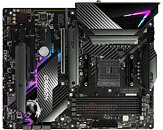
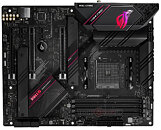
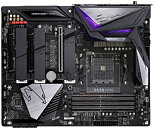
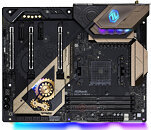
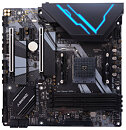
57 Comments on Assortment of Five AMD B550 Premium Motherboards Pictured
x4 (NVMe PCIe 4.0), x16/x8, x4 (NVMe 4.0), x4 (PCIe 4.0), x4 NVMe 3.0/shared x4, if I'm not mistaken.
The second NVMe slot and the second x16 slot (operating at x4 judging by the silk screening) are apparently each getting four CPU lanes.
One PCIe x1 for Ethernet and one for an additional USB 3.x controller?
X570 owners must be salty right now.
No saltiness at all, super happy with my board.Keep in mind that a lot of the I/O is shared. The chipset only supports a total of six PCIe 3.0 lanes.
See my post above about what Gigabyte did as a work around. Not sure about the other boards, as it's not obvious from the labelling.
- Two M.2, one with PCIe 4.0 x4 and another SATA.
- Two PEG, one with PCIe 4.0 x16 and the other PCIe 3.0 x16
- Realtek ALC 1220 sound chip.
- Six USB 3.0
- strong VRM at least 8 phase on doublers, and most important...
- no gay light!
You won't get a secondary x16 slot though, on any consumer board, from AMD or Intel. At most, it'll be x4, if you don't want to share bandwidth with the x16 slot for the GPU.
Also, the B550 chipset doesn't have enough PCIe lanes for what you want.
The VRM will still fry before it gets past needing more than a single 8 pin connector.
Well looks like X570 ended up being way more capable afterall. At least B550 boards have gen 4 for all of the CPU connected lanes except the chipset which is 3.0. No more archaic gen 2, I mean it was an issue that the FX series boards only supported 2.0, when Intel had gone fully 3.0.
Two USB 3.2 Gen 2 ports (instead of 8),
Six USB 2.0 ports (instead of 4)
4+4 SATA3 (instead of 4+8).
No PCIE 4.0 communication from chipset to CPU